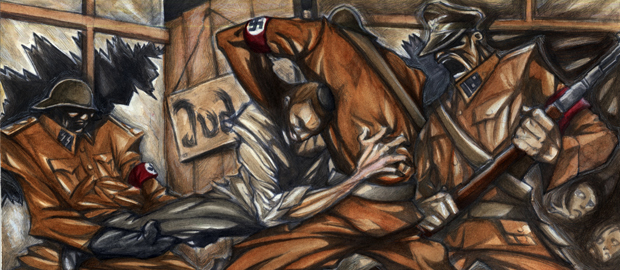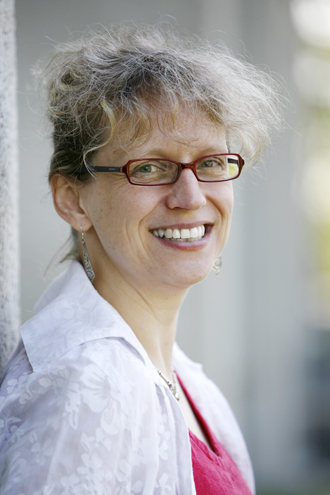Seventy-five years later, Kristallnacht invokes national reflection
Four questions for professor Sabine von Mering
 Illustration/Nate Ripp
Illustration/Nate RippArtist Nate Ripp illustrated a Holocaust inspired narrative, pieced together from various researched accounts

Sabine von Mering
On the night of November 9, 1938, Nazi thugs orchestrated attacks against nearly 1,000 synagogues and Jewish businesses across Germany and Austria. Along with non-Jewish Germans, they burned and looted Jewish-owned businesses, hospitals, schools and homes, and rounded up some 30,000 Jewish men for imprisonment in concentration camps.
The next morning, the streets sparkled with the broken glass of Jewish-owned storefronts. Kristallnacht marked a turning point in the Nazis’ march toward the Final Solution and the Holocaust. On the 75th anniversary of “the night of broken glass,” scholars still grapple with the ramifications of that watershed event.
BrandeisNow spoke with professor Sabine von Mering, director of the Center for German and European Studies, about the meaning of Kristallnacht in Germany today.
Are there common misconceptions about Kristallnacht?
It’s important to remember that Kristallnacht was the first and only large-scale pogrom in Nazi Germany. Jews had been deported and tortured since the Nazis came to power in 1933, and there were open boycotts of Jewish businesses, but this was the only mass anti-Jewish event the Nazis orchestrated of such magnitude. And it was the last. The German people were disgusted by the mess. There was glass all over the streets and burned buildings. The German people said, “This is not who we are. We don’t like messy things.” Germans like things orderly, and the Nazis learned that lesson from Kristallnacht. After that, the Nazis resorted for a while to operating more frequently in darkness — seizing Jews from their homes at night, putting them in plain, dark cars, and taking them away to concentration camps with little fanfare. There was, of course, a lot of anti-Semitism depicted on signs, in pamphlets, and in newspaper headlines, and anti-Jewish laws were being enacted almost weekly. And during the war, marches to the deportation trains often took place in broad daylight.
What about the half-million Jews living in Germany at the time? How did Kristallnacht affect them?
Kristallnacht really changed the atmosphere and the understanding of that time. Until Kristallnacht, a lot of people still hoped Hitler wouldn’t last — including many Jews. After Kristallnacht, no one said that anymore. Over the next 10 months — until Germany invaded Poland on Sept. 1, 1939, and started World War II — Jews scrambled to get out of Germany any way they could.
You’ve taught both German and American students about World War II and the Holocaust. How do their perspectives differ?
The day after Kristallnacht, the Nazis rounded up Jewish men and marched them through the streets. These were respectable people — business owners, community leaders — and many German citizens lined up to spit on them and throw things at them. It was a humiliating procession. And it was supposedly done in the name of Germans — the Nazis’ idea was that the Germans were the true Aryans, a superior race. German students are always confronted with the question, what would I have done if I had been there? What did my grandparents do? Americans don’t have to ask themselves those questions.
How is Kristallnacht remembered in Germany?
There are many commemorations of Kristallnacht in Germany because it was the only mass, anti-Jewish pogrom in the country, and it took place in every city and town. Even though the Berlin Wall came down on Nov. 9, 1989, Germans celebrate that anniversary on Oct. 3 because of the importance of Kristallnacht.
There will be an on-campus Kristallnacht commemeration on Monday Nov. 11 at 6:30 p.m. in the Mandel Humanities Center 303.
For more information about artist Nate Ripp, visit www.thenateripp.com
Categories: Humanities and Social Sciences, International Affairs





